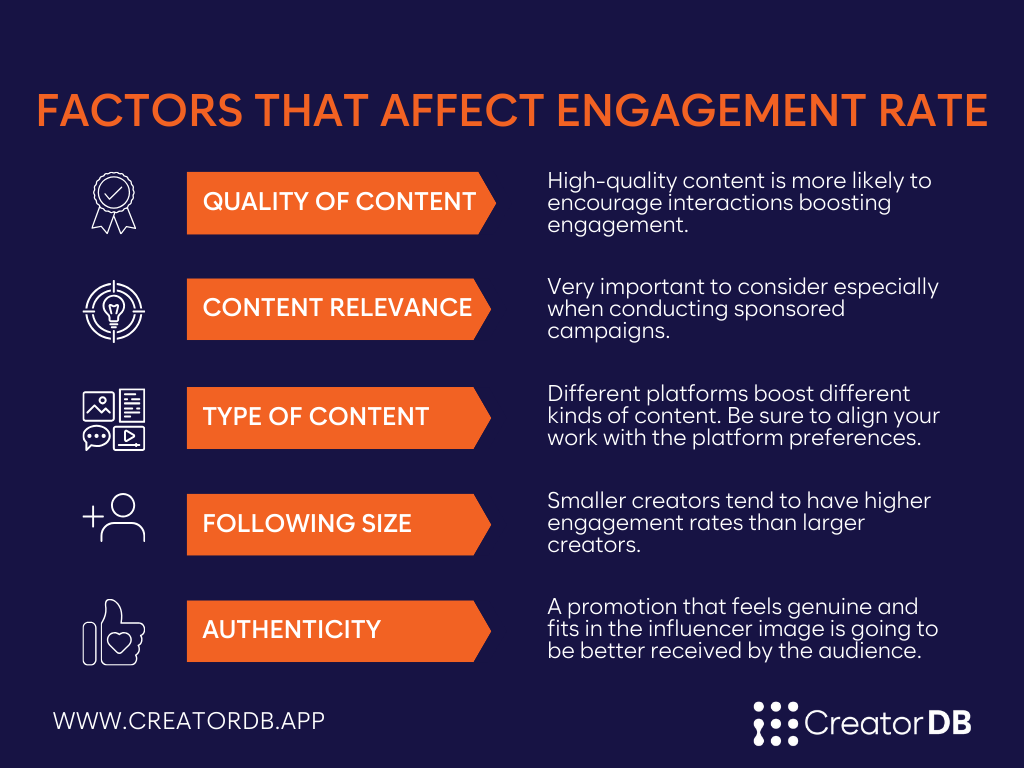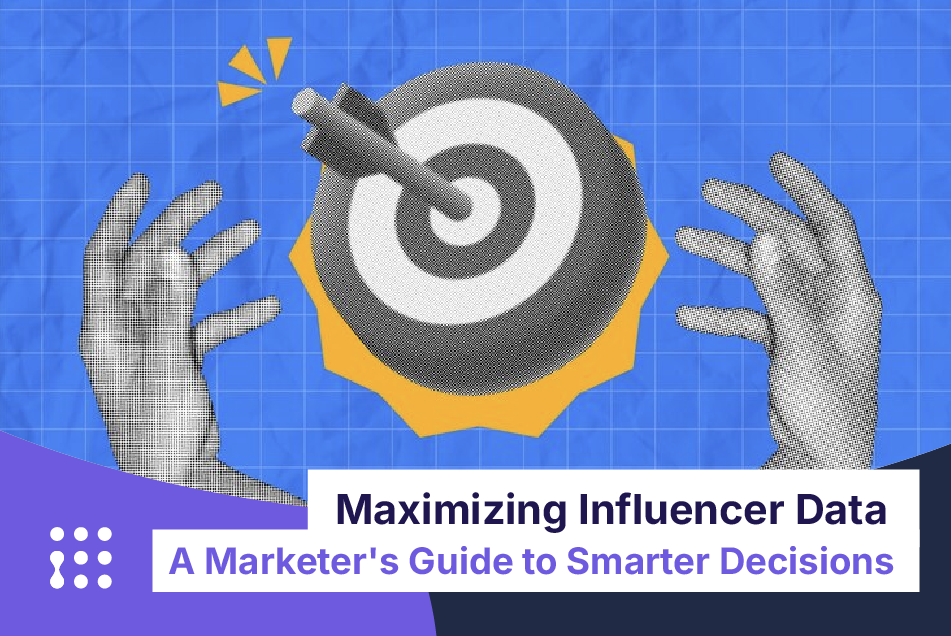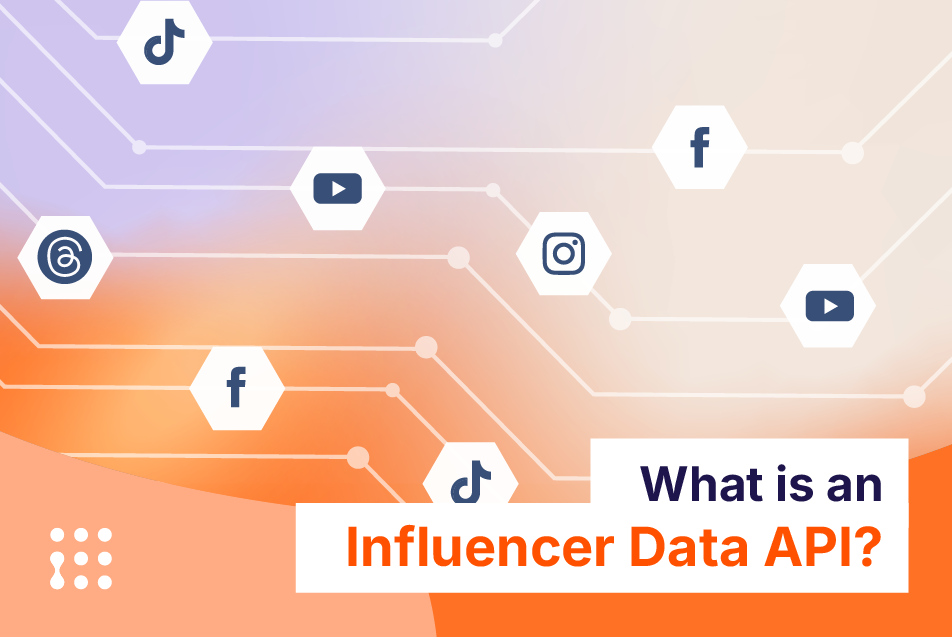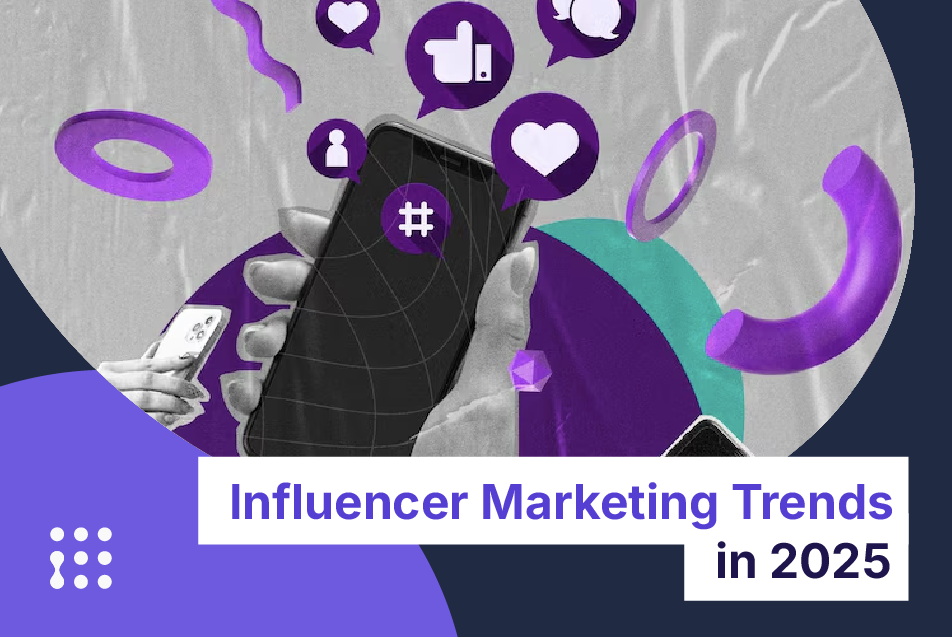In influencer marketing, engagement rates are essential. A high engagement rate indicates that an influencer’s audience is interested in their content, which points to an audience that trusts and connects with the influencer.
When applied to influencer marketing campaigns, highly engaged content increases brand awareness, sales, and brand loyalty.

What are engagement rates?
Engagement rates are metrics that measure the level of interaction and involvement an audience has with content, often used in the context of social media and online marketing.
It quantifies how often people interact with content, such as liking, commenting, sharing, or clicking on posts. Typically, the engagement rate includes all active actions an audience takes toward a post, offering a comprehensive view of engagement levels.
The engagement rate helps content creators and marketers understand how well their content resonates with their audience, indicating its effectiveness in capturing attention and prompting action.
How to calculate the engagement rates?
The engagement rate is calculated by dividing the number of interactions (likes, comments, shares, etc.) by the number of followers and multiplying by 100.
You can measure engagement rates for each post to see how well it performs, or average them to assess how effectively an influencer’s content connects with their audience. We can use various metrics to calculate the engagement rate and gain insights into specific aspects of a content creator’s audience.
However, using such a catch-all metric will not be as effective in evaluating specific aspects. For example, if you want to create discussion around your campaign, you may prefer to look specifically at comments when calculating your engagement rate to individuate creators whose audience is already highly vocal about related topics.
Why are engagement rates important in influencer marketing?
Engagement rates are critical in influencer marketing because they provide insight into the effectiveness of an influencer’s content. A high engagement rate indicates that the influencer’s content resonates with their audience and their followers actively engage with it.
Many social media algorithms promote highly engaging content showing it to more users, and, more often, how they calculate engagement rate changes from platform to platform.
But engagement rates are not everything. Learn about other essential metrics in our Analytics 101
Engagement rates are essential in an influencer marketing campaign. Similarly to what is said for organic content, users are likely to engage with sponsored posts if they find them interesting.
Since highly engaging content is boosted, investing in content creators with a high engagement rate not only means that many people in the influencer audience will see and react to the content but also that many in adjacent niches will propose such content organically, expanding the reach of your campaign.
Evaluating in comparison with other metrics with other metrics, such as reach and impressions, can provide a comprehensive understanding of the effectiveness of an influencer marketing campaign. Reach refers to the number of unique individuals who have viewed the influencer’s content, while impressions refer to the total number of times the content has been viewed.
By comparing engagement rates with reach and impressions, brands can evaluate the effectiveness of their influencer marketing campaigns and identify areas for improvement.

Factors that affect engagement rates
Engagement rates reflect the level of interaction and responsiveness between influencers and their audience. Factors such as content quality, relevance to the target audience, content type, and follower count all have an impact. By understanding and optimizing these factors, brands, and influencers can enhance their strategies and achieve higher engagement rates, resulting in more successful influencer marketing campaigns.
Quality of content
The quality of an influencer’s content is one of the most critical factors affecting their engagement rates. High-quality content is more likely to engage followers, encourage them to interact with the influencer’s content, and increase their likelihood of sharing it with their followers.
Influencers can improve the quality of their content by investing in high-quality visuals, incorporating informative and entertaining captions, and creating authentic content that aligns with their brand.
Relevance to the target audience
Another critical factor is the relevance of the content to the influencer’s target audience. The influencer’s content should align with their followers’ interests, values, and preferences. Since content creators are generally more in touch with their audience than the marketers who hire them is essential to consult with them on how to structure an effective brand collaboration.
Type of content
The type of content an influencer creates can also impact their engagement rates. The content should align with the influencer’s brand and interests while being relevant and engaging to their followers.
Concurrently different platforms promote different content in different ways: Instagram, until recently, had a preference for Reels, while LinkedIn favorites documents. Your campaign should keep in mind these differences to be able to create content that will perform best.
Size of following
The size of an influencer’s following can also impact their engagement rates. While big influencers with larger followings may have a broader reach, their engagement rates may be lower than micro-influencers or mid-tier influencers.
This is because smaller influencers often have a more loyal following, and their followers may feel a stronger connection to them. Brands can work with influencers of different sizes based on their marketing objectives and target audience.
Authenticity
Another factor that can affect engagement rates is the influencer’s authenticity. Followers can tell when an influencer is not genuine or promotes a brand or product that does not align with their values. Authenticity is crucial in influencer marketing, and influencers who are transparent and authentic in their content are more likely to build a loyal following highly reactive to their posts.
Brands can work with influencers who align with their values and ethos, ensuring the partnership feels authentic and genuine.

How to improve engagement rates in influencer marketing
Enhancing engagement rates is crucial in influencer marketing, as it determines the effectiveness of campaigns in capturing and retaining audience attention. Influencers can significantly improve engagement rates by engaging with followers, optimizing post timing, and collaborating with fellow influencers.
These strategies foster a deeper connection with the audience, increase content relevance, and expand reach, resulting in more successful influencer marketing campaigns.
Engaging with followers
Engagement is a two-way street, and influencers who actively engage with their followers can significantly improve their engagement rates. Responding to comments, addressing questions, and showing genuine interest in their audience’s opinions fosters community and connection.
Influencers can create a more interactive and engaging environment by initiating conversations, asking for feedback, and encouraging followers to participate. This increases engagement rates and strengthens the relationship between the influencer and their followers, fostering loyalty and advocacy.
Timing of posts
The timing of posts plays a crucial role in maximizing engagement rates. Influencers should analyze their audience’s behavior and identify the optimal times when their followers are most active on social media. By scheduling posts during these peak times, influencers can increase the visibility and likelihood of engagement with their content.
Collaborating with other influencers
Collaborating with other influencers is an effective strategy to boost engagement rates. By partnering with influencers who share a similar target audience or complement their niche, influencers can tap into a new pool of followers and expand their reach.
Collaborative content, such as joint videos, guest posts, or shoutouts, not only exposes the influencers to each other’s followers but also creates a sense of novelty and excitement. This often leads to increased engagement as followers are curious about the collaboration and eager to participate in the conversation.

Conclusion
In conclusion, engagement rates hold immense importance in influencer marketing. These rates serve as a vital metric to gauge the effectiveness and impact of influencer campaigns. Engagement rates provide valuable insights into content’s success and engagement levels by measuring the level of interaction and responsiveness between influencers and their audience.
High engagement rates indicate that influencers effectively connect with their audience, foster brand awareness, and drive meaningful actions such as likes, comments, and shares. Furthermore, engagement rates help brands assess influencer marketing campaigns’ return on investment (ROI) and make informed decisions about collaborations and content strategies.
With the ever-evolving social media landscape, authenticity and transparency will remain paramount. Audiences increasingly seek genuine connections and relatable content, leading to a shift towards micro-influencers offering niche expertise and more authentic engagements.
Additionally, as technology advances, metrics, and analytics tools will become more sophisticated in measuring engagement beyond likes and comments, incorporating qualitative factors such as sentiment analysis and feedback. Moreover, with the rise of emerging platforms and formats, influencers, and brands must adapt their strategies to optimize engagement rates in these new spaces.
In summary, engagement rates are a vital metric determining influencer marketing campaigns’ success and effectiveness. Influencers can continuously improve their by emphasizing quality content, understanding the target audience, engaging with followers, optimizing post timing, collaborating with other influencers, and staying ahead of trends.
With the evolution of influencer marketing and the dynamic nature of social media platforms, influencers, and brands must remain adaptable and innovative to maximize engagement rates and achieve long-term success in the ever-evolving landscape of influencer marketing.




